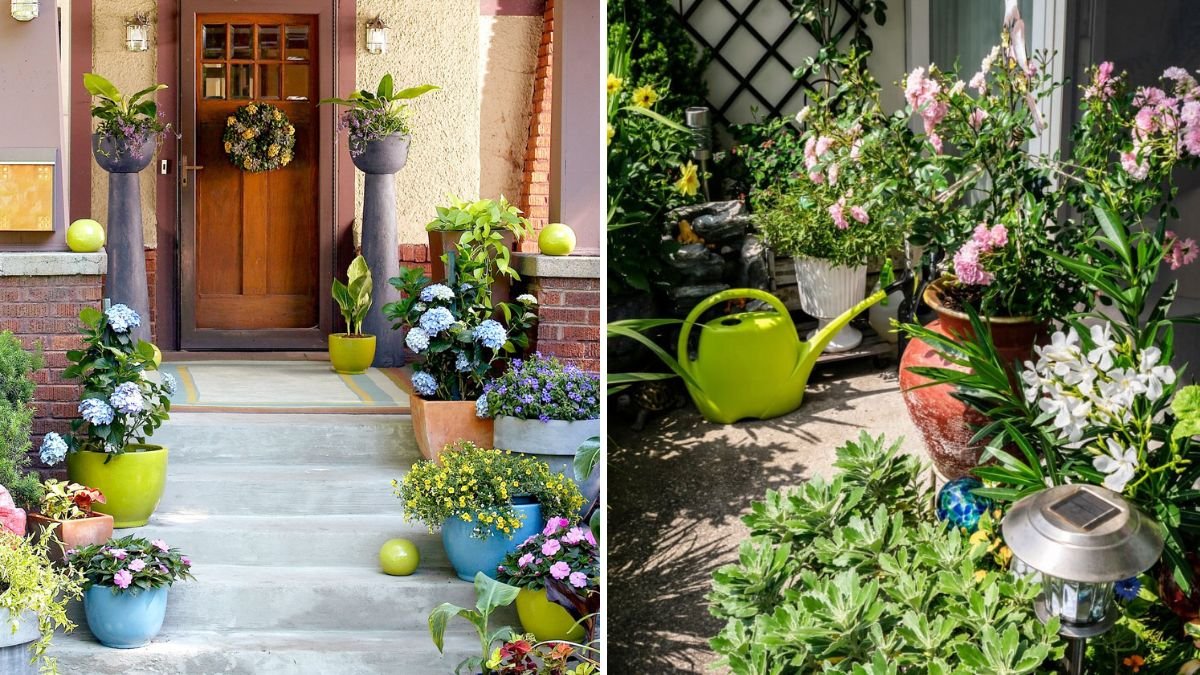Container gardening is a versatile and stylish way to bring greenery and color to patios, balconies, and small outdoor spaces. Unlike traditional in-ground gardens, container gardening allows flexibility, creativity, and mobility. With thoughtful arrangement, containers can transform a plain patio into a vibrant, inviting outdoor retreat. This article explores eight creative ways to arrange containers on a patio, providing detailed insights into plant selection, layout, aesthetics, and maintenance strategies to help gardeners maximize both beauty and functionality.
1. Layered Heights for Visual Interest
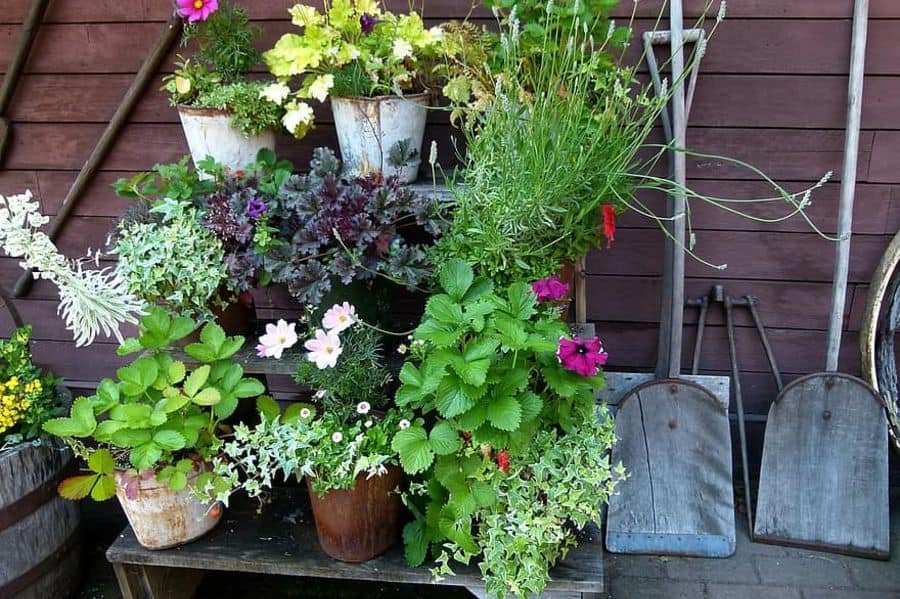
One of the most effective ways to make a patio visually appealing is by layering containers of different heights.
- Technique: Use plant stands, risers, or stacked containers to create vertical layers. Place taller plants like sunflowers, ornamental grasses, or small shrubs at the back or center. Medium-sized plants such as petunias, geraniums, or fuchsias can occupy middle levels, while trailing plants like ivy, lobelia, or creeping jenny cascade from the lowest containers.
- Benefits: This method adds depth, prevents a flat appearance, and ensures every plant gets adequate sunlight.
- Tips: Mix pots of various materials (ceramic, terracotta, and metal) for texture and visual interest.
Layered heights allow a dynamic and lush patio garden without occupying too much floor space.
2. Grouping by Plant Type or Color Scheme
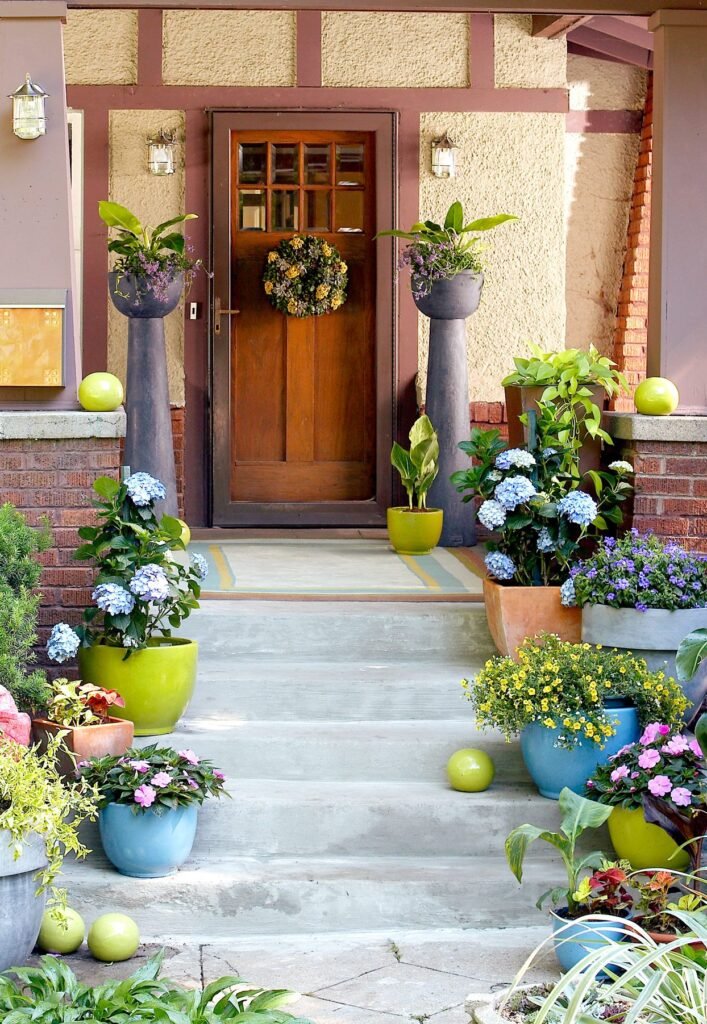
Grouping containers based on plant type or color palette creates harmony and cohesion on the patio.
- Technique: Cluster plants with similar bloom colors, foliage, or textures. For example, create a monochromatic blue-and-purple grouping with lobelia, salvia, and verbena, or a tropical theme with ferns, caladiums, and begonias.
- Benefits: Enhances visual impact and makes the patio feel organized and intentional.
- Tips: Use varying heights and container shapes within the same color scheme to avoid monotony.
Color-themed arrangements create a designer look, making your patio both vibrant and stylish.
3. Symmetrical Arrangements for Balance
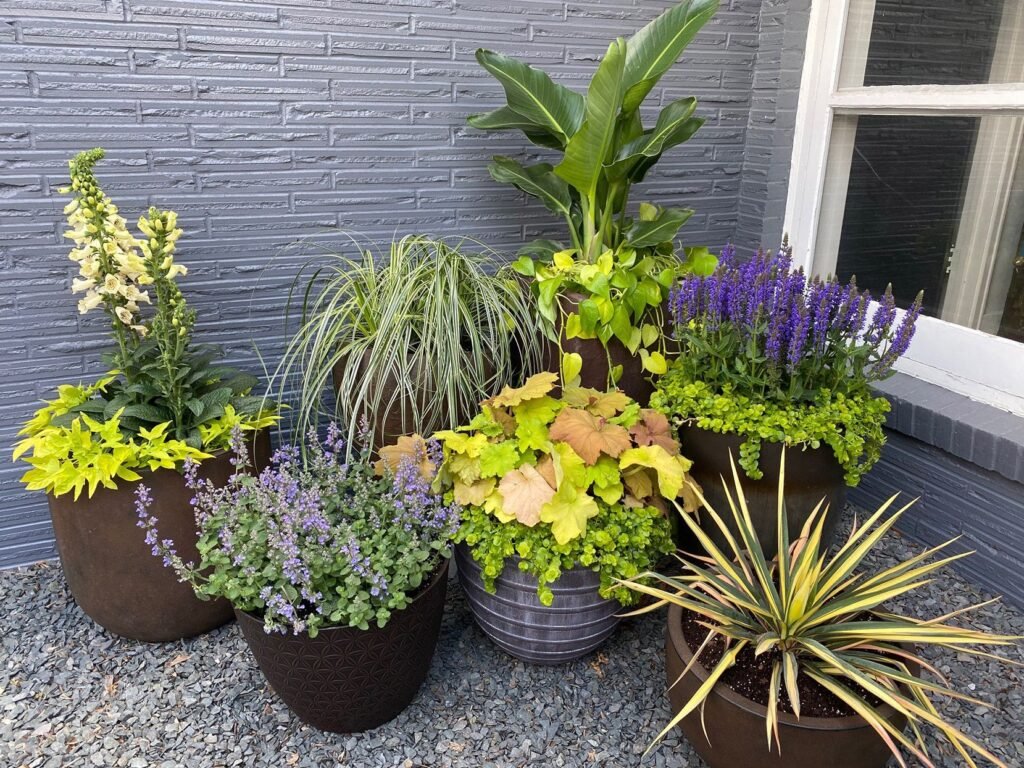
Symmetry can create a sense of order and elegance on patios.
- Technique: Place identical or matching containers on either side of a patio entrance, stairway, or seating area. You can use tall urns, matching ceramic pots, or symmetrical planter boxes.
- Benefits: Perfect for formal patios or those with structured layouts. Symmetry naturally draws the eye and creates a pleasing balance.
- Tips: Plant matching flowers in identical containers or repeat foliage patterns for a cohesive effect.
Symmetrical arrangements give a classic, balanced aesthetic ideal for patios with traditional designs.
4. Asymmetrical Arrangements for a Natural Look
Asymmetry offers a relaxed, organic vibe, perfect for contemporary or eclectic patios.
- Technique: Position containers of different shapes, heights, and sizes in unbalanced clusters. Use varying plant textures and colors to create a carefree, garden-like feel.
- Benefits: Mimics natural landscapes, allowing flexibility and creativity.
- Tips: Include trailing plants to soften edges and connect containers visually. Consider mixing large and small pots without a strict pattern.
Asymmetrical arrangements encourage a casual, inviting atmosphere, ideal for cozy outdoor lounging.
5. Vertical Container Gardens
For small patios, vertical gardening maximizes space while adding greenery.
- Technique: Use hanging baskets, wall-mounted planters, vertical towers, or stacked crates. Plant trailing vines like sweet potato vine or creeping jenny, or small flowering plants like pansies and petunias.
- Benefits: Saves floor space, adds height, and creates a living wall effect.
- Tips: Ensure adequate sunlight and choose lightweight containers for safety. Use a consistent watering system, as vertical setups tend to dry faster.
Vertical gardens turn even tiny patios into lush, layered spaces without overcrowding the floor.
6. Multi-Textured Container Arrangements
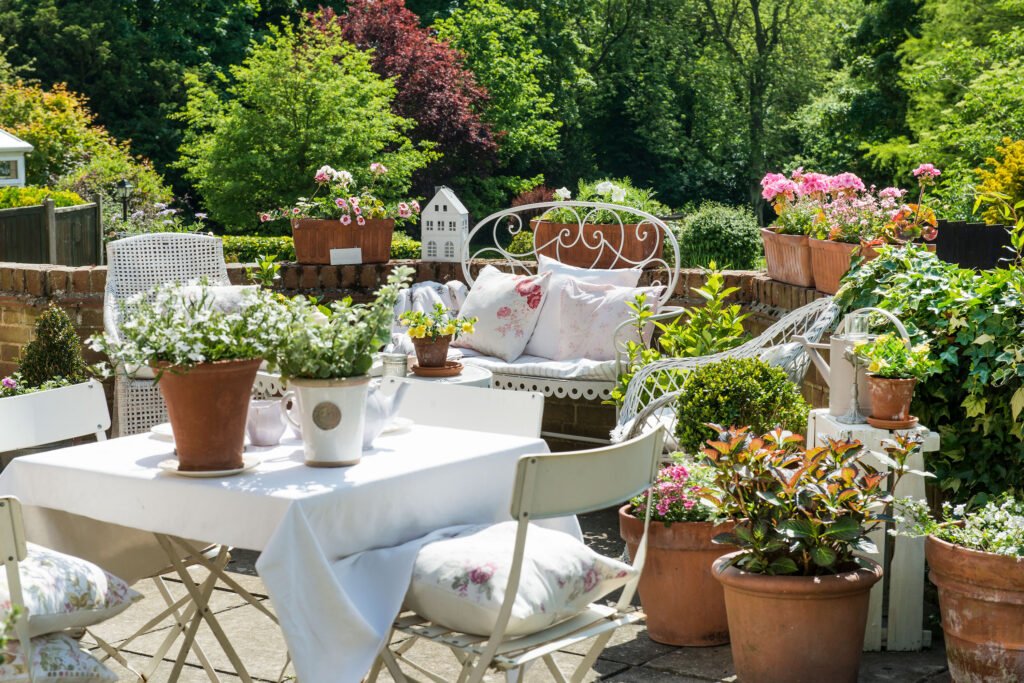
Combining different textures, foliage types, and flowers creates visual richness.
- Technique: Mix smooth ceramic pots with rustic terracotta, glossy metal containers with wicker baskets. Combine spiky plants like ornamental grasses, soft foliage like ferns, and colorful blooms like geraniums or impatiens.
- Benefits: Creates depth and dimension, making the patio visually engaging from every angle.
- Tips: Incorporate contrasting leaf shapes, flower forms, and container finishes for an artistic effect.
Multi-textured arrangements highlight individual plants while unifying the patio design.
7. Seasonal Rotations
Changing container arrangements with the seasons ensures the patio remains vibrant year-round.
- Technique: In spring and summer, focus on annuals like petunias, marigolds, and zinnias. Transition to fall mums, pansies, or ornamental kale in autumn. In winter, evergreen containers with boxwood, heather, or dwarf conifers maintain greenery.
- Benefits: Keeps your patio fresh and lively throughout the year.
- Tips: Use pots that are easy to move and store to simplify seasonal rotations.
Seasonal rotations ensure continuous beauty and variety, making the patio appealing in every season.
8. Creating Focal Points with Statement Containers
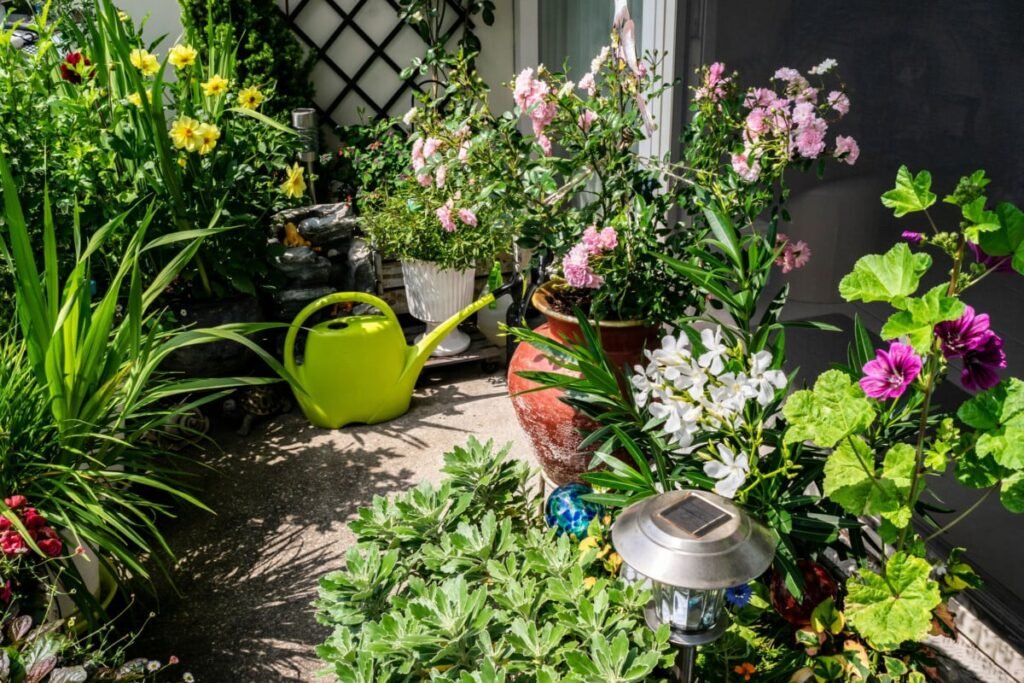
Focal points draw attention and elevate the overall patio aesthetic.
- Technique: Use large, colorful, or uniquely shaped containers as a centerpiece. Plant bold, eye-catching flowers like sunflowers, hydrangeas, or fuchsias, or incorporate topiary or ornamental grasses. Surround the focal container with smaller complementary pots.
- Benefits: Provides a central anchor for the eye, organizing the patio visually.
- Tips: Vary textures and colors around the focal point to enhance depth and interest.
A focal container creates a dramatic statement, turning the patio into a mini-showcase garden.
Additional Tips for Patio Container Gardening
To ensure your container arrangements thrive, consider these essential strategies:
1. Container Selection
- Choose containers with drainage holes to prevent root rot.
- Materials like terracotta, ceramic, metal, or plastic each have different thermal properties and aesthetics.
2. Soil and Fertilization
- Use high-quality potting mix with organic matter for nutrient retention.
- Fertilize regularly with slow-release or liquid fertilizers to support continuous blooms.
3. Watering
- Containers dry faster than ground soil; water consistently, especially in summer.
- Use self-watering pots or saucers to reduce watering frequency.
4. Grouping Containers
- Place pots in clusters of odd numbers (3, 5, or 7) for a natural, pleasing visual effect.
- Use color repetition or complementary foliage to tie the arrangement together.
5. Accessibility and Maintenance
- Arrange containers so watering, pruning, and deadheading are easy.
- Ensure plants receive appropriate sunlight based on species needs.
Benefits of Creative Container Arrangements
- Flexibility: Containers can be moved and rearranged easily.
- Customization: Allows for unique designs, color schemes, and seasonal changes.
- Space Efficiency: Ideal for small patios or urban settings.
- Enhanced Aesthetics: Adds vertical, horizontal, and textural interest.
- Reduced Soil Issues: Avoids problems associated with poor native soil.
Thoughtful container arrangements turn even the simplest patio into a stylish and flourishing outdoor space.
Conclusion
Arranging containers creatively on a patio transforms ordinary outdoor spaces into vibrant, inviting, and functional gardens. By using strategies like layered heights, color-themed groupings, symmetry, vertical gardening, textural diversity, seasonal rotations, and focal points, gardeners can maximize visual impact and ensure plant health.
Key Takeaways:
- Layer containers by height for depth and dynamic appeal.
- Group plants by type or color to create harmony.
- Balance symmetry and asymmetry according to your patio’s style.
- Use vertical gardening for space optimization.
- Mix textures and foliage types for visual interest.
- Rotate plants seasonally to maintain year-round beauty.
- Create focal points with statement containers.
- Ensure proper soil, watering, and maintenance for thriving plants.
By combining aesthetic design with practical care, a container-filled patio can become a personal oasis of color, greenery, and charm, providing enjoyment, relaxation, and curb appeal throughout the year.
